F-71can be compared to "engines" in our cars) - see Figure F2 (c). The Oscillatory Chamberrepresents a completely new type of device (of the author's invention) that produces asuper powerful, pulsating magnetic field. Each such chamber takes the form of atransparent cubical box, empty inside, along the inner walls of which streams of electricsparks are rotating. The rotation of these sparks produces a magnetic field. Therefore asingle Oscillatory Chamber represents an extra powerful magnet, whose field is capable oflifting heavy loads because of the repulsive interaction with the Earth's magnetic field.Unfortunately the output from a single Oscillatory Chamber is difficult to control. Therefore,for the propelling purposes two of these devices must be arranged into a controllablesystem called the "twin-chamber capsule". An example of such capsule is shown in FigureF2 (c). Each twin-chamber capsule contains a small "Inner" Oscillatory Chamber whichfree-floats inside a bigger "Outer" one. In this way, one of these two Chambers interceptsand circulates (C) a part of the output from the other Chamber, thus directing to thecapsule's environment only the appropriate fraction (R) of the total magnetic flux. In order topropel and manoeuvre the Magnocraft, each twin-chamber capsule must also be rotable inrelation to the vehicle's body. For this reason each capsule must be placed inside aspherical casing which enables the capsule to turn, and, by this means, to change the angle(I) of its thrust action - see Figure F2 (a). Therefore, the final name "magnetic propulsor" isgiven to such resultant apparatus which incorporates: a spherical casing, a twin-chambercapsule, capsule turning devices, and output control system.The crew cabin (1) of the Magnocraft is located between the main (M) and side (U)propulsors - see Figure F2 (a). It takes the shape of a parallel-piped ring. This cabin lookssimilar to the side walls of an inverted saucer and is covered by a material which isimpenetrable by the magnetic flux. This material is to shield people inside from thedestructive action of powerful magnetic fields. The shell of this crew cabin is also mirror-likewith a controlled degree of transparency and light reflection. Therefore, when flying near theSun crew can make their vehicle reflect the light completely, whereas at night they canmake the vehicle totally transparent. The final structure of the Magnocraft incorporates itscrew cabin, propulsion unit, log-computer, and other devices into a single functional system.The side appearance of this structure is shown in Figure F2 (b).The general shape of the Magnocraft is strictly defined by the "K" factor mentionedearlier. Symbol "K" for this factor originates from the word "Krotnosc" which in the Polishlanguage means "ratio of the vehicle's diameter to its height". This is because the value of"K" is determined by the mutual ratio of the Magnocraft's outer diameter "D" and its height"H" (from base to top), i.e.: K = D/H. The "K" factor is extremely important for the design ofthe Magnocraft, because it determines all the design parameters of this vehicle, including itsdimensions and shape. To illustrate how much the Magnocraft is dependent on this factor,main equations which describe the most important dimensions of this vehicle are listedbelow (notice that the deductions of all these equations are contained in chapter F fromvolume 3 of monograph [1/4], while illustration of these equations is provided in Figure F18from volume 3 of monograph [1/4]). Outer diameter "D" of the Magnocraft (i.e. the maximaldiameter of its flange) is described by the equation: D=0.5486*2 K meters (note that theconstant 0.5486 meter appearing in this equation represents a unit of length called "cosmiccubit" because it must be applied for Magnocraft dimensioning by all civilizations whichbuild these vehicles). Height "H" of the Magnocraft is described by the equation: H=D/K.Outer diameter "D M " of the main propulsor's spherical casing is equal to: D M =D(2-/2)/K.Nominal diameter "d" of the circle on which centres of the outlets from side propulsors arelocated is expressed by the equation: d=D//2=(0.5486*2 K )//2 meters. (This "d" diameterdescribes also the nominal dimension of the ring of scorched marks left on the ground by alanded Magnocraft.) Note that: D-d=2L, where: L=0.25*K*D M .Magnetic laws working in the Magnocraft cause that the "K" factor can not take everypossible value, but this factor is restricted only to one of the following integer numbers: K=3,K=4, K=5, K=6, K=7, K=8, K=9, K=10. Therefore only eight main types of the Magnocraft
F-72can be built, each type taking a different value from the above range of integer numberspermitted for the "K" factor. Because of the value this "K" factor obtains, the consecutivetypes of the Magnocraft are called K3 (i.e. having the K factor equal to K=3), K4 (i.e. forwhich K=4), K5, K6, K7, K8, K9, and K10. Such system of naming the subsequent types ofMagnocraft allows for an extremely easy retrieval of data about any type of this vehicle. Forexample, when someone analyses the K6 type of the Magnocraft, it is evident that for thistype the "K" factor is equal to K=6. Thus, according to the equations listed before, maindimensions of this vehicle are as follows: D=35.11, H=5.85, DM=3.43, d=24.82, L=5.14metres; whereas the number of its side propulsors is: n=20. The "K" factor can easily bedetermined from photographs, radar images, videos, or outlines of flying vehicles, simply bymeasuring how many times the height "H" of a given vehicle is fully contained within itsouter diameter "D" (actually the "K" factor can be determined automatically by a computerprogram or by a microprocessor built-in into a radar-like tracking device). Therefore thisfactor is extremely useful for the fast identification of all the Magnocraft-like vehicles.Because the same magnetic laws must also apply for the Magnocraft-like vehicles built byother civilizations, the described here manner of identifying these vehicles by the value oftheir "K" factor is universal and applicable to UFOs as well.F2. The operation of the MagnocraftManoeuvring the Magnocraft is achieved as the result of a combination of threedifferent actions. The first of these is to change the relation between the output from thepropulsors which produce attracting (A) and repelling (R) forces; this causes the ascent,hovering and descent of the craft. The second action is to slant at an angle (I) the magneticaxes of certain propulsors, from their parallel orientation towards the local course of theforce lines of the environmental magnetic field. This produces the meridian component ofthe thrust force, causing the horizontal flight of the Magnocraft from south to north or northto south. Above the equator, where the field's force lines are parallel to the ground, such acomponent is produced when the magnetic axes of propulsors are slanted from a horizontalorientation. The third action is to produce a magnetic whirl spinning around the Magnocraftand to control the direction and power of the whirl. This whirl (in a principle similar to therotation of a cylinder in the "Magnus effect" already known in hydromechanics), produces ahorizontal thrust force perpendicular to the force lines of the Earth's magnetic field. If thismagnetic whirl rotates in such a way that the landing Magnocraft causes the counterclockwiseflattening of plants in the southern hemisphere (or clockwise in the Northernhemisphere), the longitudinal component of the thrust force created will propel the craft in adirection from west-to-east. The opposite rotating whirl will propel the craft from east-towest.The magnetic whirl is obtained by creating 90 degree phase shifts in the pulsation of amagnetic field yielded from the subsequent side propulsors (i.e. in a manner similar toproducing a magnetic whirl in asynchronous electric motors). One of the side effects of thiswhirl is that it ionizes air around the Magnocraft, thus producing a powerful glow. For thisreason the Magnocraft flying in a west/east direction must glow strongly (during daylight thisglow could be comparable to the shining of the Moon - as described in Maori legends).The propulsion of the Magnocraft, which combines together the three actions listedabove, causes the flight of this vehicle to have a magnetic character which drastically differsfrom the aerodynamic (smooth) flights of aeroplanes and the inertial thrusts of rockets.Apart from silent flights and enormous speeds (around 70,000 km/h in the atmosphere andnear the speed of light in free space), the following attributes characterize the magneticmovements of the Magnocraft: (a) always having the same orientation of the vehicle,independently of the direction in which it flies (i.e. its base is always kept almostperpendicular to the local course of Earth's magnetic field force lines), (b) flying mainlyalong straight lines that in many cases correspond to the force lines of Earth's magnetic
- Page 1 and 2:
Proof Copy ([5e/3] reformatted to P
- Page 3 and 4:
3G-83 G. Evidence certifying that M
- Page 5 and 6:
5Notes:(1) Before this monograph wa
- Page 7 and 8:
A-2or disk"). The information which
- Page 9 and 10:
A-4immune deficiency, thus it is qu
- Page 11 and 12:
A-6edition, 1986) even tries to arg
- Page 13 and 14:
A-8changes have no connection with
- Page 15 and 16:
A-10Fig. A2. The curved slope in th
- Page 17 and 18:
B-12inspired me to suspect that hum
- Page 19 and 20:
B-14Earth by evil UFOnauts God trie
- Page 21 and 22:
C-16#10. The spread, radiating from
- Page 23 and 24:
C-18"Te Ura-a-Te Raki-Tamau", which
- Page 25 and 26: C-20item #2 that follows). Thus, in
- Page 27 and 28: C-22comparative data which reflects
- Page 29 and 30: C-24exploding fires, columns of fir
- Page 31 and 32: C-26banks of the Black Gully Creek,
- Page 33 and 34: C-28meditating, conducting healing
- Page 35 and 36: C-30deaths of people with symptoms
- Page 37 and 38: C-32(1) The Kawakawa volcano erupte
- Page 39 and 40: C-34The Tapanui Crater is the centr
- Page 41 and 42: C-36Fig. C2. The inner topography o
- Page 43 and 44: C-38(a)(d)(b)(c)(e)Fig. C4. Example
- Page 45 and 46: C-40Fig. C6. The illustration of si
- Page 47 and 48: C-42Fig. C8. The distribution of in
- Page 49 and 50: C-44Fig. C10. Two photographs of a
- Page 51 and 52: C-46Fig. C12. The location of near-
- Page 53 and 54: C-48Fig. C14. A magnetized metallic
- Page 55 and 56: D-50Chapter D:EVIDENCE THAT THE TAP
- Page 57 and 58: D-52including Mediterranean and Biz
- Page 59 and 60: D-54rapidly released by this explos
- Page 61 and 62: D-56experiments, and many more. Thi
- Page 63 and 64: D-58that people were in medieval ti
- Page 65 and 66: D-60then continually resonates in t
- Page 67 and 68: D-62"tapanui.htm") are to be met, s
- Page 69 and 70: D-64when such abnormalities of the
- Page 71 and 72: E-66Chapter E.HYPOTHESES EXPLAINING
- Page 73 and 74: E-68is directed towards the magneti
- Page 75: F-70publication of this design and
- Page 79 and 80: F-74sites an explosive growth of mu
- Page 81 and 82: F-76F4. Explosion sites of the Magn
- Page 83 and 84: F-78- Deficiency of some sensitive
- Page 85 and 86: F-80(a)…(b)…(c)Fig. F2. The des
- Page 87 and 88: F-82Fig. F4. The explanation for a
- Page 89 and 90: G-84The formal proof that "UFOs are
- Page 91 and 92: G-86civilization(s) sending UFOs mu
- Page 93 and 94: G-88the close proximity of the Tapa
- Page 95 and 96: G-90(c)(d)Fig. G1. Two photographs
- Page 97 and 98: G-92(a)(c)(b)(d)(e)Fig. G3. A spher
- Page 99 and 100: G-94(a)(b)(c)(d)Fig. G5. Pulsating
- Page 101 and 102: G-96(a)(b)(c)(d)(e)Fig. G7. Smooth,
- Page 103 and 104: G-98(a)(b)(c)(d)Fig. G9. Photograph
- Page 105 and 106: H-100#6. The Tapanui Crater is orie
- Page 107 and 108: I-102Chapter I:MORAL ACCENTUATION O
- Page 109 and 110: J-104explosion energy carrier would
- Page 111 and 112: J-106detonation a number of appropr
- Page 113 and 114: J-108resembled "china stones" from
- Page 115 and 116: K-110Chapter K:AROUND 13 500 YEARS-
- Page 117 and 118: K-112civilisation were prepared for
- Page 119 and 120: L-114Chapter L:STILL ANOTHER UFO EX
- Page 121 and 122: L-116Coincidentally, the author had
- Page 123 and 124: M-118in section D3). This in turn h
- Page 125 and 126: N-120Chapter N:TWELVE TRUTHS ABOUT
- Page 127 and 128:
N-122only factors which may cause t
- Page 129 and 130:
N-124ones who stand by truth and th
- Page 131 and 132:
O-126Chapter O:ACADEMIC ASPECTS OF
- Page 133 and 134:
O-128Galactic field, thus producing
- Page 135 and 136:
O-130specifically what was wrong wi
- Page 137 and 138:
O-132moral field causes that we acc
- Page 139 and 140:
O-134white glowing balls of playful
- Page 141 and 142:
O-136brought disgrace to that unive
- Page 143 and 144:
O-138the Polish language only, whic
- Page 145 and 146:
O-140occupation of Earth, and then
- Page 147 and 148:
O-142in a few years of time, when t
- Page 149 and 150:
O-144and both these matters were se
- Page 151 and 152:
O-146today. We need to realize this
- Page 153 and 154:
O-148Of course, the above history i
- Page 155 and 156:
O-150two kinds of resource publicat
- Page 157 and 158:
R-152Chapter R:AT THE END OF THIS M
- Page 159 and 160:
R-154forget that such paid scientis
- Page 161 and 162:
S-156Chapter S:REFERENCES COMPLEMEN
- Page 163 and 164:
S-158[7/2] Giordano D. and Pajak J.
- Page 165 and 166:
T-160Magnocraft exploded over New Z
- Page 167 and 168:
Z-162Appendix Z:Directions for gett
- Page 169:
Z-164Fig. Z1. The most educational


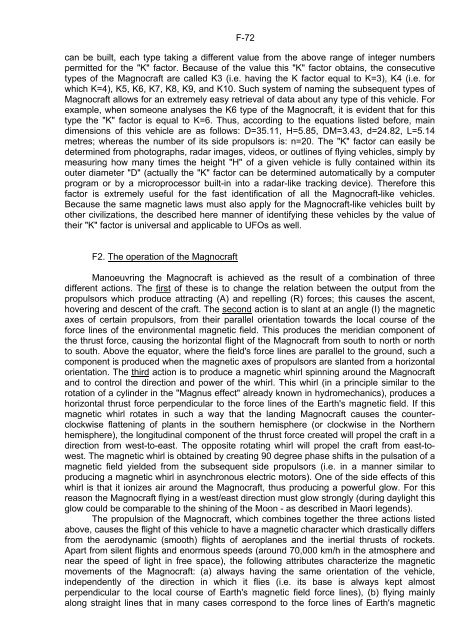
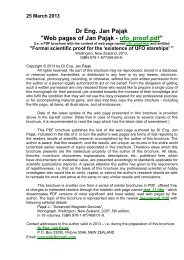


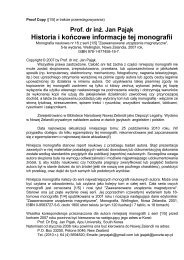
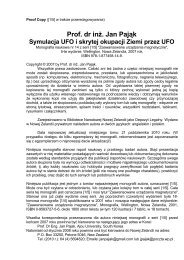
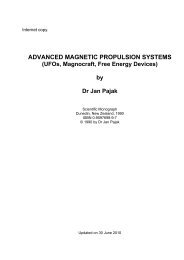
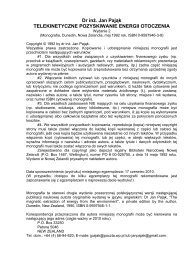
![[1/4p]: PDF - Totalizm](https://img.yumpu.com/45003232/1/184x260/1-4p-pdf-totalizm.jpg?quality=85)
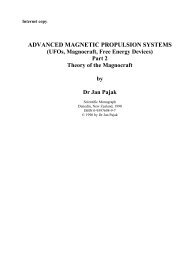
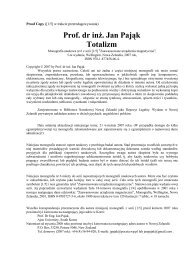
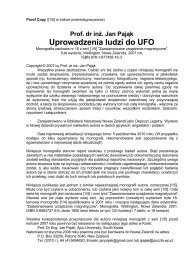
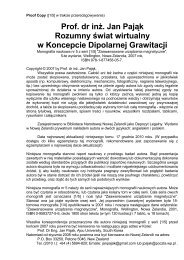
![[1/4p]: PDF - Totalizm](https://img.yumpu.com/39351336/1/184x260/1-4p-pdf-totalizm.jpg?quality=85)
